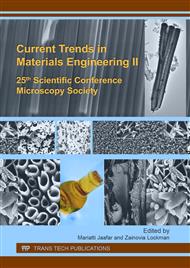[1]
J. Xu, L. Wang, X. Cao, Polymer supported graphene–CdS composite catalyst with enhanced photocatalytic hydrogen production from water splitting under visible light, Chemical Engineering Journal, 283 (2016) 816-825.
DOI: 10.1016/j.cej.2015.08.018
Google Scholar
[2]
M.G. Walter, E.L. Warren, J.R. McKone, S.W. Boettcher, Q. Mi, E.A. Santori, N.S. Lewis, Solar water splitting cells, Chemical reviews, 110 (2010) 6446-6473.
DOI: 10.1021/cr1002326
Google Scholar
[3]
Z. Bai, Y. Zhang, CdS nanoparticles sensitized large-scale patterned ZnO nanowire arrays for enhanced solar water splitting, Journal of Solid State Electrochemistry, (2016) 1-7.
DOI: 10.1007/s10008-016-3325-1
Google Scholar
[4]
C. Zhang, M. Shao, F. Ning, S. Xu, Z. Li, M. Wei, D.G. Evans, X. Duan, Au nanoparticles sensitized ZnO nanorod@ nanoplatelet core–shell arrays for enhanced photoelectrochemical water splitting, Nano Energy, 12 (2015) 231-239.
DOI: 10.1016/j.nanoen.2014.12.037
Google Scholar
[5]
X. Yang, A. Wolcott, G. Wang, A. Sobo, R.C. Fitzmorris, F. Qian, J.Z. Zhang, Y. Li, Nitrogen-doped ZnO nanowire arrays for photoelectrochemical water splitting, Nano Letters, 9 (2009) 2331-2336.
DOI: 10.1021/nl900772q
Google Scholar
[6]
A. Wolcott, W.A. Smith, T.R. Kuykendall, Y. Zhao, J.Z. Zhang, Photoelectrochemical water splitting using dense and aligned TiO2 nanorod arrays, Small, 5 (2009) 104-111.
DOI: 10.1002/smll.200800902
Google Scholar
[7]
L.E. Greene, M. Law, D.H. Tan, M. Montano, J. Goldberger, G. Somorjai, P. Yang, General route to vertical ZnO nanowire arrays using textured ZnO seeds, Nano Letters, 5 (2005) 1231-1236.
DOI: 10.1021/nl050788p
Google Scholar
[8]
G. Amin, M. Asif, A. Zainelabdin, S. Zaman, O. Nur, M. Willander, Influence of pH, precursor concentration, growth time, and temperature on the morphology of ZnO nanostructures grown by the hydrothermal method, Journal of Nanomaterials, 2011 (2011).
DOI: 10.1155/2011/269692
Google Scholar
[9]
J. Cheng, K.M. Poduska, Ambient Degradation of ZnO Powders: Does Surface Polarity Matter?, ECS Journal of Solid State Science and Technology, 3 (2014) P133-P137.
DOI: 10.1149/2.011405jss
Google Scholar
[10]
M. Guo, P. Diao, S. Cai, Hydrothermal growth of well-aligned ZnO nanorod arrays: Dependence of morphology and alignment ordering upon preparing conditions, Journal of Solid State Chemistry, 178 (2005) 1864-1873.
DOI: 10.1016/j.jssc.2005.03.031
Google Scholar
[11]
G. Hodes, P.V. Kamat, Understanding the Implication of Carrier Diffusion Length in Photovoltaic Cells, The Journal of Physical Chemistry Letters, 6 (2015) 4090-4092.
DOI: 10.1021/acs.jpclett.5b02052
Google Scholar


